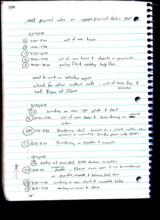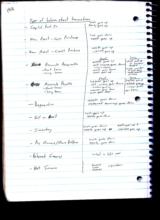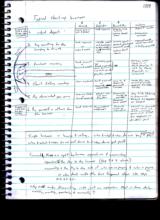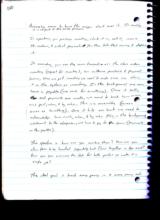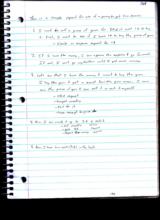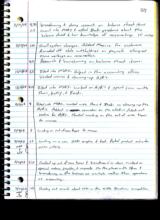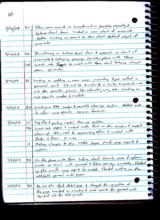|
Basic Assignments
|
Options & Settings
|
Main Time Information
|
||||||||||||||||||||||
|
|
|
|
|
|||||||||
|
|||||||||
|
|
|
Notes:
|
|
Types of Balance Sheet Transactions: - Capital Paid In: o Cash goes up o Equity goes up - New Asset – Cash Purchase: o Cash goes down o Assets goes up - New Asset – Credit Purchase o Assets goes up o Liabilities goes up - Accounts Receivables: o Short term: • Assets goes up • Net income goes down • When closed: • Assets goes down • Cash goes up o Long term: • Assets goes up in long term A/R’s • Assets goes down in some other asset account or cash - Accounts Payable: o Short term: • Liabilities goes up • Net income goes down • When paid on: • Liabilities goes down • Cash goes down o Long term: • Liabilities goes up • Assets goes up • When paid: same as short • Liabilities goes down • Cash goes down - Depreciation: o Assets goes down o Retained earnings goes down - Sell on Asset: o Cash goes up o Assets goes down - Inventory: o Cash goes down – assets goes up o OR o Assets goes up and liabilities goes up - Pay Owners/Share Holders: o Cash goes down o Equity goes down - Retained Earnings: o What is left over - Net Income: o Revenue o COGS o Expenses o Operations Typical Start-up Business: 1. Initial deposit: (happens at first and then maybe later if needed) o $ Source: • Capital paid in • Out of pocket o $ Destination: • Bank account o $ Record By: • Positive bank account • Balance sheet item o Actions: • Deposit made • Transaction recorded 2. Buy something for the company to do work: (loops within the list – loops between 2 & 5, and mini loops between 3 & 4) o $ Source: • Bank account or • Loans & credit o $ Destination: • Into the asset and eventually to the vendor who sold the item o $ Record By: • Money spent • Product purchased • Amount owed • Balance sheet items o Actions: • Receipt made • Asset recorded • Liability recorded 3. Purchase Inventory: o $ Source: • Bank account or • Loans & credit o $ Destination: • Pay the vendor o $ Record By: • Inventory going up • Bank account goes down or • Liabilities goes up o Actions: • Purchase order • Stock it in • Start paying it off by showing payments on account 4. Start Selling Inventory: o $ Source: • From customers o $ Destination: • Bank account or • Accounts receivables o $ Record By: • Invoice & • Deposits • Payments made o Actions: • Make the sale record payments • Deposit available funds 5. Pay down what you owe: o $ Source: • Revenue/sales or • Bank account o $ Destination: • Vendor who we owe payables o $ Record By: • Payments made to vendor • Decrease amt. owed o Actions: • Pay bills, statements, or payments • Refund as expense or COGS 6. Pay yourself or others from the business: (happens at a set time, say semi-monthly) o $ Source: • Bank account o $ Destination: • Share holders • employees o $ Record By: • Payments made to individuals o Actions: • Record as payments lower what we owe and money goes out • Could be expenses or dividends paid Other accounting notes: - Simple business in buying and selling. Who & what & when do we buy from & when do we pay? - Who & what & when do we sell items to & when do we get paid? - Currently there is a split between operations and accounting: o Operations are the day to day business (step 3 & 4 above) o Accounting is the day to day side of who are we paying and who is paying us o It deals with the less frequent steps like steps 1, 2, 5, & 6. - Why not make Accounting into just an operation that is done daily, weekly, monthly, quarterly, and annually? - Accounting seems to have this magic cloud over it. In reality it is all part of the same process. - In operations, you purchase inventory, stock it in, sell it, invoice the customer, and collect payment. You then take that money and deposit it. - In accounting, you see the same transaction as: The store orders inventory (request for inventory), you authorize purchase and payment terms. Once we get inventory we need to make sure we show it in the system as inventory. In the background we now have a payable (we owe for something). Once it sells and payments are made, we need to track how much was paid, when, and by who. This is a receivable (someone owes us something). Once it hits our bank we need to acknowledge how much, when, and by who. Also, in the background unbeknownst to the salesperson, we have to pay for the items (payments on the payables). - The question is how can you combine them? How can you allow them to be handled separately but flow together in the end? How can you minimize the steps for both parties or make it a single job? - The ideal goal is track every penny in & every penny out. This is a sample request for use of a penny to get two pennies: 1. I want to sell a piece of gum for $0.02, and it cost $0.01 to buy it. First, I need to see if I have $0.01 to buy the piece of gum. - Create an expense request for $0.01 2. If I have the money, I can approve the expense and go forward. If not, I can’t go any further until I get more money. 3. Let’s say that I have the money and want to buy the gum. I buy the gum and get a receipt from the gum man. I now own the piece of gum and can sell it or eat it myself. - Oked request - Bought inventory - Paid for it - Have receipt to prove it 4. Now, I can mark it up to $0.02 & sell it. - Sell inventory – invoice - Get $0.02 - payment - Deposit the money – deposit 5. Now, I have two dollars ($0.02) in the bank |

